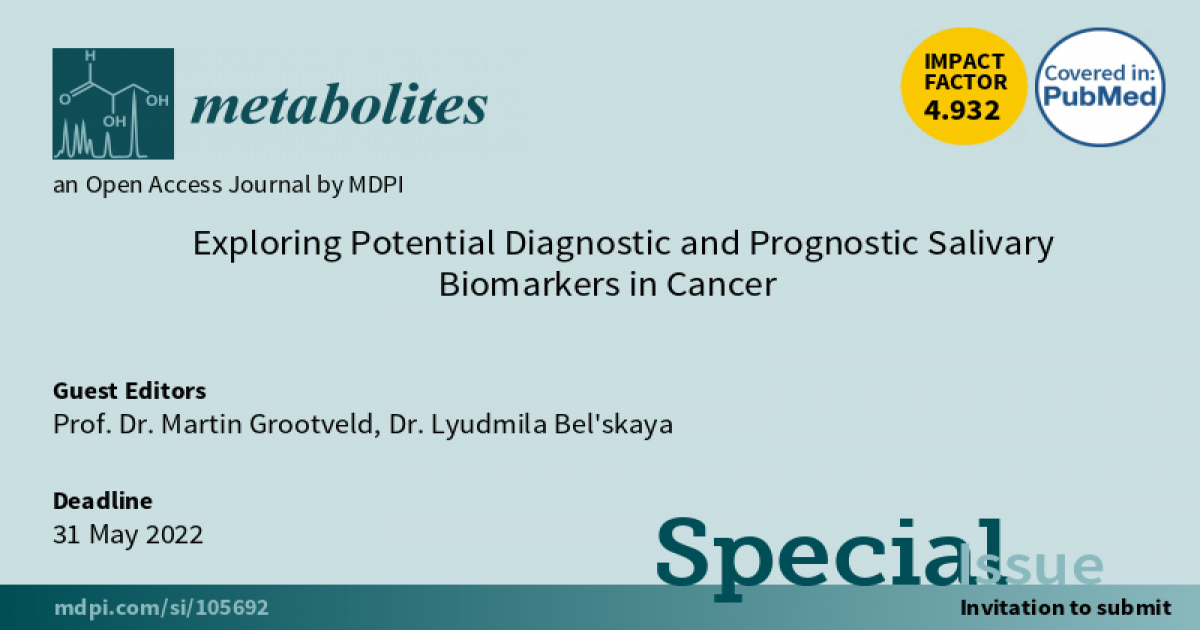Exploring Potential Diagnostic and Prognostic Salivary Biomarkers in Cancer
A special issue of Metabolites (ISSN 2218-1989). This special issue belongs to the section "Endocrinology and Clinical Metabolic Research".
Deadline for manuscript submissions: closed (31 May 2022) | Viewed by 25285

Special Issue Editors
Interests: chemical pathology; clinical chemistry; NMR-based metabolomics; disease diagnosis and prognostic monitoring; metabolic pathway analysis; bioinorganic chemistry; drug design; development and synthesis; artificial intelligence; machine learning; research ethics
Special Issues, Collections and Topics in MDPI journals
Interests: salivary biomarkers; lung cancer; breast cancer; diagnosis; prognosis
Special Issues, Collections and Topics in MDPI journals
Special Issue Information
Dear Colleagues,
Recently, the attention of researchers to the study of human saliva as a biofluid with unique properties and diagnostic capabilities has increased. Indeed, a new term, “salivaomics”, has been proposed, which brings together knowledge about various components in saliva, including the genome, epigenome, transcript, proteome, metabolome, and microbiome. This has led to the development of new technologies and validation of a wide range of salivary biomarkers that will soon render saliva a valuable tool in clinical practice. Particular attention is paid to the search for new biomarkers and combinations of salivary biomarkers for the early diagnosis of cancer. Currently, the first steps are being taken towards evaluating the role of salivary biomarkers in the prognostic monitoring of cancer conditions. However, additional research investigations are required for the successful transfer of NMR-based salivary metabolomics to actual clinical use as a diagnostic benefit for clinicians, researchers, and patients alike. Therefore, this Special Issue is planned to include current research on the use of salivary biomarkers for the diagnosis and prognosis of cancer. Its major focus is to evaluate the future perspectives of reported observations acquired from metabolomics studies focused on evaluations of the diagnosis and prognostic tracking of salivary biomarkers for both oral and non-oral (systemic) cancers, the former including head and neck cancer, and oral cavity squamous cell and oropharyngeal squamous cell carcinomas, the latter featuring head and squamous cell, lung, breast, pancreatic and prostate cancers, among others.
Prof. Dr. Martin Grootveld
Dr. Lyudmila Bel'skaya
Guest Editors
Manuscript Submission Information
Manuscripts should be submitted online at www.mdpi.com by registering and logging in to this website. Once you are registered, click here to go to the submission form. Manuscripts can be submitted until the deadline. All submissions that pass pre-check are peer-reviewed. Accepted papers will be published continuously in the journal (as soon as accepted) and will be listed together on the special issue website. Research articles, review articles as well as short communications are invited. For planned papers, a title and short abstract (about 100 words) can be sent to the Editorial Office for announcement on this website.
Submitted manuscripts should not have been published previously, nor be under consideration for publication elsewhere (except conference proceedings papers). All manuscripts are thoroughly refereed through a single-blind peer-review process. A guide for authors and other relevant information for submission of manuscripts is available on the Instructions for Authors page. Metabolites is an international peer-reviewed open access monthly journal published by MDPI.
Please visit the Instructions for Authors page before submitting a manuscript. The Article Processing Charge (APC) for publication in this open access journal is 2700 CHF (Swiss Francs). Submitted papers should be well formatted and use good English. Authors may use MDPI's English editing service prior to publication or during author revisions.
Keywords
- salivary biomarkers
- metabolomics
- salivaomics
- diagnosis
- prognosis
- cancer
Benefits of Publishing in a Special Issue
- Ease of navigation: Grouping papers by topic helps scholars navigate broad scope journals more efficiently.
- Greater discoverability: Special Issues support the reach and impact of scientific research. Articles in Special Issues are more discoverable and cited more frequently.
- Expansion of research network: Special Issues facilitate connections among authors, fostering scientific collaborations.
- External promotion: Articles in Special Issues are often promoted through the journal's social media, increasing their visibility.
- e-Book format: Special Issues with more than 10 articles can be published as dedicated e-books, ensuring wide and rapid dissemination.
Further information on MDPI's Special Issue polices can be found here.







